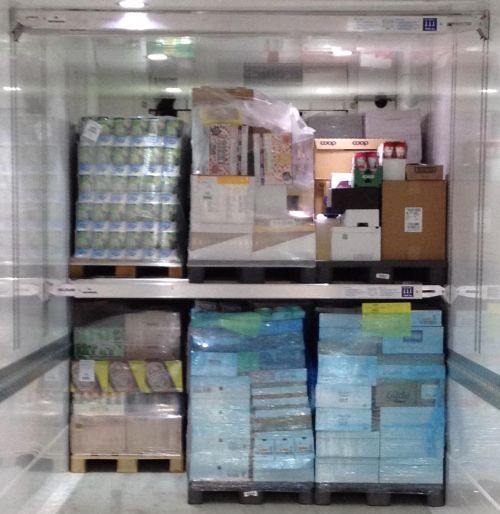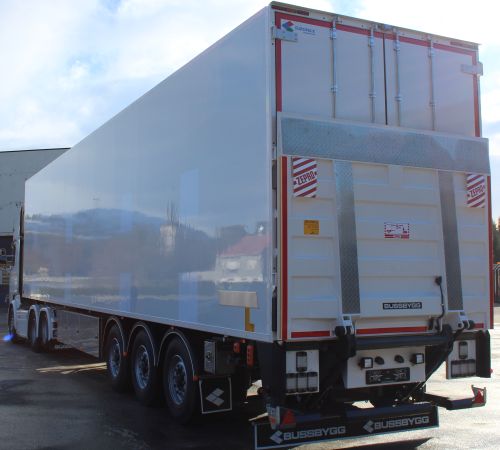Norwegian truck and semi-trailer body works company Bussbygg has teamed with transport firm Fosen Transport and RFID provider HRAFN for an ongoing trial of an RFID-enabled refrigerated trailer and cloud-based software system that tracks the locations of palletized products within a truck’s cargo area or the trailer hitched to that vehicle, and also ensures that the pallets are delivered to the correct customer.
Bussbygg makes and sells 250 custom fiberglass refrigerated trailers annually. The company says its trailers cost more than traditional metal trailers commonly used in other parts of Europe, but offer higher value since the fiberglass provides better insulation to keep the cold products inside the trailer cold. Fiberglass trailers offer another advantage, the company has found: They are more compatible with radio frequency identification technology. Metal trailers reflect the transmissions of ultrahigh-frequency (UHF) RFID readers and, therefore, makes RFID use challenging. What’s more, installing RFID antennas inside a metal trailer means attaching each antenna to the interior wall, which compromises the space inside and also leaves antennas vulnerable to being knocked loose or damaged.

“We were happy when [HRAFN] contacted us about RFID,” says Toril Hovdenak, Bussbygg’s CEO. “We had already thought RFID was part of our future, but we weren’t sure how we would use it. What makes this a perfect match is that we don’t use a lot of metals in our products.”
Bussbygg began working with HRAFN to install an RFID reader antenna array directly within a trailer wall’s fiberglass layers, says Geir Vevle, HRAFN’s CTO, so that the antennas are not visible and do not compromise the trailer interior. The only modification Bussbygg had to make, Hovdenak says, was to replace the aluminum reinforcements inside the trailer with others made of fiberglass. HRAFN also installed reflectors behind the antennas to ensure that RF radiation stays focused inside the trailer.
Fosen Transport, one of Bussbygg’s larger customers, acquired two of the RFID-enabled trailers and has since been piloting them to determine what data can be collected as the two trucks transport goods to one of its retailer customers, Coop Norge.
The system employs a CAEN RFID R4300P Ion UHF RFID reader with an integrated GPRS modem, along with a GPS device that plugs into the reader’s USB port. The reader was installed in the front of the container near the refrigeration unit. More than 10 antennas were embedded in the walls (HRAFN declines to reveal the exact number) with half on each side, spaced across the length of the trailer at multiple locations—one on the floor and a second one above that at about 120 centimeters (47 inches). The reader operates each antenna sequentially, via an antenna multiplexer provided by Keonn, and sends the collected read data to HRAFN’s cloud-based Electronic Product Code Information Services (EPCIS) software whenever there is a GPRS connection.
Fosen Transport’s drivers move goods between Oslo and Bodø. Because of the distance between distribution centers and retail stores, shipments are at risk for unforeseen challenges and human mistakes, says Kathrin Fründt, Fosen’s project manager for research and development. In the event that a delivery is delayed, she says, product inside the truck could become damaged or ruined. Other errors that could have expensive repercussions include a driver delivering a pallet of product to the wrong location. If that occurs, then any perishable foods might need to be discarded by the time the error is identified.
In 2010, Fosen began seeking an automated solution so that it could know, in real time, where its products were located and when they were delivered. At that time, the company installed RFID antennas inside one of its semi-trailers and found that the RFID reader could interrogate tags inside and then forward that data back to a server. “At that point,” Fründt says, “it was a very simple solution with antenna panels screwed onto the inside panels of the trailer.” The positive results of that test, along with feedback from both Fosen’s staff and customers, led the company to seek a permanent solution “with built-in antennas which do not reduce the loading capacity of the trailer,” she adds.
The pilot with Bussbygg began this past spring for two trailers traveling from Fosen’s distribution centers in Oslo and Trondheim to Coop’s retailer stores in Røros, and back to the main Oslo DC.
The pilot consists of Norsk Lastbærer Pool (NLP) reusable pallets that come with embedded UHF RFID tags. Most suppliers and retailers in Norway are already using these pallets, Vevle says, though few are utilizing the RFID functionality in them thus far. Inside the trailer is an array of PDF100 antennas developed by HRAFN and a Trondheim company named Norant, Vevle says. As goods are loaded into the trailer, the antennas capture each pallet’s tag ID and the reader links the collected tag data with the trailer’s GPS location, then forwards that information back to the HRAFN EPCIS-based software via a cellular connection.
The software stores data linking each pallet’s unique RFID number with information about the goods loaded on that pallet, as well as and where it is destined for delivery. The GPS coordinates of that destination (a Coop store) are also stored in the software.
When a pallet is removed from the trailer, the reader no longer detects its tag ID and, within a specific amount of time, the HRAFN software concludes that the tagged pallet has been delivered to a customer. The software then stores that status update, along with the GPS location.
“We share our data openly with our customer,” Fründt states, “since one of the goals is to reduce lead time, as well as increase quality and customer service throughout the value chain.”
The system not only provides Fosen’s managers with real-time data regarding where its trucks are located and what has been loaded onto and unloaded from each vehicle, but also helps to prevent mistakes. Because HRAFN software stores data indicating which pallets are expected to be delivered to which sites based on their GPS coordinates, it knows if a pallet has been removed from a truck at the wrong location, and can issue an alert via text message to company managers, as well as to the driver before he leaves that location. Similarly, if the driver leaves a delivery location without dropping off all necessary pallets, the software identifies that event, since each pallet’s tag is still being read within the truck, and the driver and company management can receive an alert.

Additionally, the solution can send a notification to retailers once HRAFN’s EPCIS software determines that the truck, and thus the retailer’s order, is within 30 minutes of delivery. The technology also provides Fosen Transport with proof of loading and unloading in the event of a dispute involving whether a load has been delivered. Consequently, drivers no longer need to present paperwork for signature to the receiving party at the retail location, and the retailer need not compare the goods against an order list to confirm that the delivery is complete and accurate. To date, Bussbygg has found that deliveries to Coop stores are about 30 minutes faster.
The next step, Fründt says, will be to test the system with regular wooden pallets that have RFID tags attached to them. “We are hoping to finish testing this fall/winter,” she says. Fosen’s next step, Fründt explains, is to integrate RFID into its operations so that it can make the technology available to its customers. “Being aware of the potential of RFID technology, and that best results will only be obtained by equipping as many trailers as possible with RFID technology, one also have to bear in mind that both truck and trailer have high investment costs. Trailers will be equipped with RFID technology subsequently as trailers will get renewed.”
Bussbygg will make RFID-enabled trailers for any transportation companies that request it, Hovdenak says, noting that the company expects its larger customers to benefit from RFID more than smaller ones. “It would be an extra cost,” she adds, so it would need to provide value to a company that had a large volume of transported goods and, therefore, the need to better manage them.



